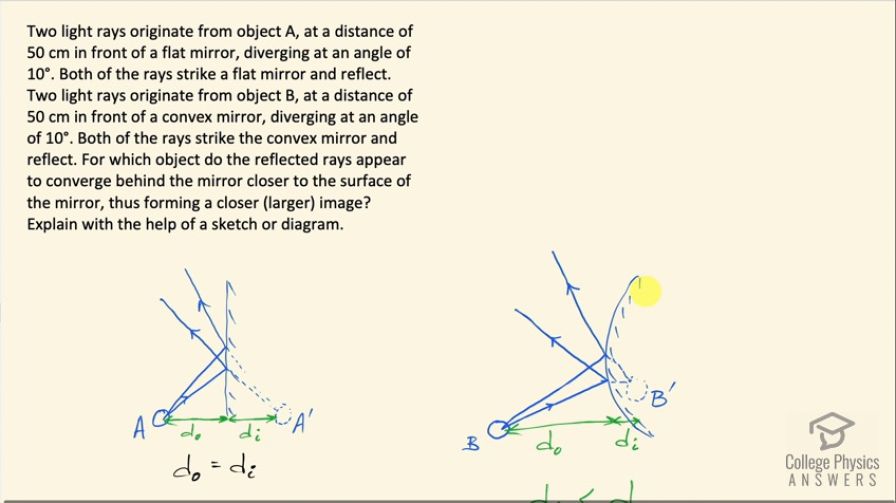Question
Two light rays originate from object A, at a distance of 50 cm in front of a flat mirror, diverging at an angle of 10°. Both of the rays strike a flat mirror and reflect. Two light rays originate from object B, at a distance of 50 cm in front of a convex mirror, diverging at an angle of 10°. Both of the rays strike the convex mirror and reflect. For which object do the reflected rays appear to converge behind the mirror closer to the surface of the mirror, thus forming a closer (larger) image? Explain with the help of a sketch or diagram.
Final Answer
Please see the solution video.
Solution video
OpenStax College Physics for AP® Courses, Chapter 25, Problem 4 (Test Prep for AP® Courses)

vote with a rating of
votes with an average rating of
.
Video Transcript
This is College Physics Answers with Shaun Dychko. We have to compare two pictures one with a plain flat mirror and the other with a convex mirror and the question is using a ray diagram, which mirror will produce an image that appears to be closer to the surface of the mirror and thus larger? So a picture with object A has two rays that are diverging by about 10 degrees we are supposed to imagine and this object distance is about 50 centimeters but the numbers don't really matter here just the point is that we have this these two rays that are emanating from object A reflecting off the mirror and when you project back to where they meet that's the position of the perceived image, which will be here A prime and so a person's eye here would project these rays back straight to where they appear to originate from, which is here and this image will be equidistant from this surface of the mirror as the object so the object distance is same as the image distance for a plain flat mirror. In the case of a convex mirror, we have the same distance suppose and the same two rays diverging with the same angle of 10 degrees as before but upon reflection, this reflected ray will be at a greater the spread apartness... if you want to put it that way... is going to be greater as a result of hitting this convex mirror so the curvature is going to bump this ray to an angle such that it is diverging more compared with the other ray versus when they were coming from the object towards the mirror. So you know here we have 10 degrees but if you were to move this ray here (I wonder if this going to work) if you were to move this here that's going to be more than 10 degrees as a result of the curvature of this mirror and because of that we are going to have... when the rays get projected back mentally by this person's eye we project the rays back to where they appear to originate from they will appear to originate here at a position that is closer to the mirror surface than the object and because it seems closer, it will seem larger too so the image distance is less than the object distance. There we go!